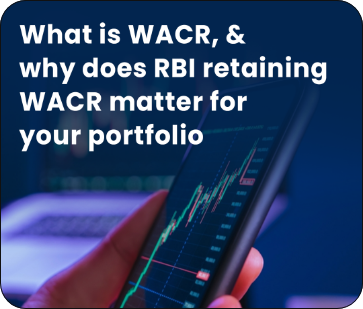
SEBI’s Specialised Investment
Funds: A Closer Look
The Securities and Exchange Board of India (SEBI) has recently introduced a Specialised Investment Fund (SIF) framework to bridge the gap between portfolio management services (PMS) and mutual funds (MFs).
This SIF framework, effective April 1, 2025 , aims to reshape the investment landscape in India. Its goal is to provide sophisticated investors with more flexible opportunities and the required regulations.
In this article, we take a closer look at SEBI’s newly published SIFs regulatory framework and what investors need to know about them.
Table Of Contents:
Introducing Specialised Investment Funds (SIFs)
Specialised Investment Funds (SIFs) are a newly introduced asset class in India, regulated by the Securities and Exchange Board of India (SEBI).
They are designed as investment vehicles that focus on niche and specialised sectors or strategies instead of broad-market investments.
You can consider them as funds that target specific areas or niches, which often tend to be non-conventional, such as SMEs, infrastructure, and startups.
This type of investment is specialised in nature and has higher risk but also offers higher return potential compared to other traditional investments.
However, these are not ideal for beginner investors, ones with a low to medium budget or lesser risk appetite.
What Is Eligibility Criteria For SIFs?
To establish a Specialised Investment Fund, asset management companies (AMCs) must meet specific eligibility criteria set by SEBI. There are two primary routes for AMCs to set up an SIF:
- Track Record-Based Route: The AMC must have at least three years of operations with an average asset under management (AUM) of ₹10,000 crore over the past three years. Additionally, no regulatory action should have been taken against the sponsor or AMC in the past three years.
- Experience-Based Route:The AMC must appoint a Chief Investment Officer (CIO) with at least ten years of experience managing an AUM of ₹5,000 crore. A secondary fund manager with three years of experience handling an AUM of ₹500 crore is also required.
All SIF applications require SEBI approval, ensuring that only well-established and experienced AMCs can offer these funds.
We highly suggest diversifying your portfolio by investing in the best smallcase in India with much flexible and simpler eligibility criteria, making them the ideal choice to start investing.
Investment Strategies For SIFs Across Various Asset Classes
SIFs are structured to offer a diverse range of investment strategies across equity, debt, and hybrid asset classes.
This flexibility allows AMCs to design products that cater to the specific needs and risk appetites of sophisticated investors. The permissible investment strategies include:
- Equity Long-Short Fund: It requires a minimum allocation of 80% to equity and equity-related instruments, with a maximum short exposure (unhedged derivative positions) of 25%.
- Equity Ex-Top 100 Long-Short Fund:It mandates at least 65% investment in equities outside the top 100 companies by market capitalisation, with a maximum short exposure of 25% in non-large-cap stocks.
- Sector Rotation Long-Short Fund: It involves a minimum of 80% investment in equity and equity-related instruments across up to four sectors, with a maximum short exposure of 25%.
1. Equity-Oriented Investment Strategies:
- Debt Long-Short Fund: This one focuses on long and short positions in debt instruments, aiming to capitalise on interest rate movements and credit spreads.
- Sectoral Debt Long-Short Fund:This type of fund targets specific sectors within the debt market, allowing for strategic positioning based on sectoral outlooks.
2. Debt-Based Investment Strategies:
- Hybrid Long-Short Fund: It combines both equity and debt positions, providing a balanced approach to long-short investing.
- Hybrid Long-Only Fund: Such strategy focuses on long positions across equity and debt instruments, aiming for capital appreciation with controlled risk.
3. Hybrid Investment Strategies:
To prevent over-proliferation and ensure clarity, SEBI has restricted each AMC to offering only one investment strategy per category under the SIF framework.
For investors with modest budgets, smallcase investment can be a better option. With comparatively lower risk and improved diversification, smallcase portfolios such as PINC Momentum Fundamental will be more suitable for you.
Conclusion
SEBI proposes a route to access specialised investment opportunities and potentially higher returns, however, it does come with increased risk, and is designed for high-net-worth investors.
This regulatory framework is established to govern SIFs ensuring optimum transparency and investor protection.
Comparing minimum investment thresholds to be higher than those for standard mutual funds, or someone with low to moderate risk appetite.
To choose the right investment option, connect with reputed wealth management services to find a customised solution depending upon your profile, goals, needs, and preferences.
We at PINC Wealth offer research-backed, expert-curated smallcase portfolios. Get started with your investment journey today!
Related Articles

How will the US Fed rate cut impact inflation, Indian markets and your investment portfolio?
US Fed rate cuts influence Indian markets, currency trends, and smallcase stocks. Explore sectors that benefit, risks, and smart investment strategies for 2025.
Know more
What is WACR, and why does RBI retaining WACR matter for your portfolio?
Understand WACR and RBI's revised liquidity framework. Learn how these monetary policy changes impact your smallcase investment and portfolio returns.
Know more
‘Bite-sized’ smallcase investments: Low entry-cost portfolios for new and young investors
Making investment even easier and simpler with ‘bite-sized’ smallcase portfolios. Here’s a guide for beginners on how to start and build long-term wealth.
Know more
Top portfolio risk assessment tools and techniques that every smallcase investor should know
Learn about the top portfolio risk assessment tools and techniques that every smallcase investor should know to analyse and manage the potential risk, and how financial advisors help in this effectively.
Know moreMeet the people
we served!
PINC Compounder Smallcase has simplified my investment journey. Seriously, investing has never been easy for me! Here in a single click, I could access a balanced portfolio. Thanks PINC.
Mr. Akhilesh
I was hesitant about investing, but PINC Smallcase changed that. Talking to their team and looking at their growth gave me confidence. I've seen my investments grow steadily since then. I'm impressed!
Devendra Palan
As someone with limited knowledge about the stock market, I found Pinc smallcase to be a reliable and accessible platform. Their detailed reports and analysis have given me a deeper understanding of the stocks in my portfolio. I feel confident in managing my investments.
Pratik Gandhi

Subscribe to our email list
Sign up for Expert Insights
Your Gateway to Smarter Wealth
Management!